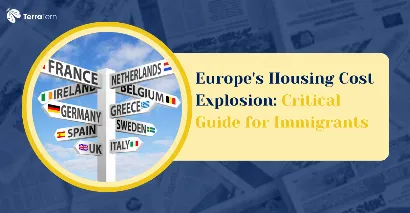Key Highlights
A massive housing affordability crisis has never been experienced in Europe, where immigrants are trying to find new opportunities throughout the continent. These market factors are essential for effective relocation planning in an adverse environment.
Housing Market Crisis Overview
The cost of housing immigrants in Europe is a factor that cannot be ignored when deciding to relocate all over the continent, since it reveals worrying trends. In the first quarter of 2025, the European Union experienced growth in house prices by 5.7%, whereas the rental cost surged by 3.2% compared to the same quarter of 2024.
These gains are in addition to more than a decade of growth. House prices have increased by 57.9 per cent since 2010 among the key EU countries, with rent costs rising by 27 per cent. Long-term pressure has brought about an estimated shortage of 9.6 million homes in Europe.
Immigrants are primarily impacted in the crisis since they do not have an established credit line, local contacts or families who support them to their native homes in negotiating their housing markets.
Also Read: Top Europe Job Consultancy in India: Experts List
Extreme Cost Variations Across European Cities
The cost variation across European cities is:
Premium Destinations: Western European Capitals
London is Europe's most expensive housing market for immigrants to buy; three-bedroom apartments in city centres are rented at a rate of 5088 euros monthly. Such a high astronomical cost renders British capital accessible to high-earning professionals or people with high savings.
Next in line is Switzerland, which has equally prohibitive costs. On average, Zurich and Geneva also cost more than three thousand eight hundred euros monthly to rent similar residences. The city of Geneva particularly tops the European ranking in apartment purchase prices at Euro 15720/square meter.
Other destinations with prohibitive prices that tax the budget of immigrants include:
-
Dublin: more than 3,200 euros/month
-
Paris: 3100+euro/Month
-
Munich: 3 thousand + per month
-
Luxembourg: over 3050 euros per month
-
Copenhagen: 2950+ euros per month
Budget-Friendly Alternatives
Athens is Europe's cheapest large city to immigrate to, with three-bedroom city centre apartments at only 1080 euros monthly. The Greek capital is very well endowed with abundant savings compared to the Western European alternatives.
Another low-cost alternative is
-
Budapest: 1,225 Euro per month
-
Istanbul: 1614 Euros per month
-
Warsaw: 1,581 euros per month
-
Helsinki: 1,928 euros per month
-
Prague: 2,100 euros a month
Regional Housing Market Analysis
|
Region |
Price Growth 2010-2025 |
Rental Trends |
Immigrant Impact Level |
|
Eastern Europe |
+150-260% |
High volatility |
Rapidly increasing burden |
|
Southern Europe |
Mixed patterns |
Varied by country |
Moderate to high impact |
|
Western Europe |
Steady premium |
Consistent growth |
Hi, Highly established burden |
|
Nordic Countries |
Moderate growth |
Stable increases |
Moderate impact |
Also Read: 14 Best Countries For Indians To Live And Work In Europe
Eastern Europe: Transformation Zone
The most dramatic changes are in Eastern European countries. Hungary tops the list of gains with house prices rising by 260 per cent since 2010, a factor that has essentially changed the way of life of immigrants in Budapest. Estonia experienced a percentage increase, and Lithuania experienced an increase in percentage points. Countries are now defying conventional norms regarding affordability in Eastern Europe.
Southern Europe: Divergent Paths
Since 2010, Portugal has witnessed more than a doubling of house prices; thus, Lisbon is getting tougher to immigrate to. On the other hand, Greece is the sole EU nation with a rent decline of 11 per cent since 2010, which is why Athens is currently affordable. Italy offers different dynamics as house prices have decreased by 4 per cent since 2010, with a regional difference between the north and the south cities.
Immigrant-Specific Housing Challenges
The housing challenges can be summarized as:
Financial Burden Statistics
Studies show that a quarter of migrants have difficulties paying housing costs, whereas, among national citizens, only 9 per cent of people have problems with this spending. This discrepancy points to a specific weakness of immigrants in the housing markets of Europe.
Key Challenges Immigrants Face:
-
Overcrowding: 36 per cent of migrants vs 17 per cent of non-migrants
-
Housing Quality Problem: 26 per cent of immigrants vs. 20 per cent native-born
-
Burden Cost: More than 40 per cent of the income on housing for 20 per cent of migrants
-
Limited Ownership: Stores and houses belonging to third-country nationals are hardly owned, as 23.3% compared to EU nationals 73.7%
Market Access Barriers
Structural ill-treatment of immigrants includes:
-
Landlord, agent discrimination: Discrimination by an agent or landlord
-
They have to be able to meet credit history requirements that are beyond their reach
-
Language issues in searching for housing
-
Being unaware of its local storage laws
-
Failure to come up with local sureties or references
Also Read: How to Get a Job in Europe From India? Experts Latest Guide
Housing Cost Projections for 2025
|
City Category |
Expected Growth Rate |
Median Rent Range |
Immigrant Considerations |
|
Tier 1 Cities |
+2.5-3.5% |
€2,500-5,000+ |
Extremely challenging entry |
|
Tier 2 Cities |
+2.0-3.0% |
€1,500-2,500 |
Moderate accessibility |
|
Tier 3 Cities |
+1.5-2.5% |
€800-1,500 |
Best immigrant opportunities |
Housing experts forecast that the rental market will persist and grow at an average rate of 2.7% in the next ten years (2025) in 32 top European cities. This increasing rate corresponds with projected wage growth, indicating that the cost of living is not worsening and may be levelled off or sped up by the financial crisis in affordability.
Nonetheless, this average conceals significant regional differences. Eastern European cities can also show greater growth with development since they can grow above average, and the regulation may also cause slower growth in some Western European markets.
Strategic Housing Planning for Immigrants
The housing planning for immigrants is:
Pre-Arrival Preparation
Effective immigrants will take time to research the housing markets before arrival. Preparation steps that are necessary entail:
-
Budgeting: Between 40-50 per cent of projected revenue should be set aside towards paying off housing expenses
-
Market Research: You must compare the target cities' rental sites and rates.
-
Touch With Expatriate: Put in touch with immigrant and expatriate groups
-
Photocopy: avail payroll letters and letters of employment, bank statements, and references
Location Selection Framework
Consider these critical factors when choosing destinations:
Economic factors:
-
Prospects of salaries in your professional field
-
Taxation levels locally and other costs besides the housing price
-
Access to the employment market among immigrants
-
Development of careers
Practical considerations:
-
Accessibility of the transportation links to the places of work.
-
Availability of cheap surrounding environments
-
The services of integration and language support services
-
The accessibility of the healthcare system
Also Read: The EU's Bold Step: Facilitating Migrants to Work and Live in Europe
Market Entry Strategies in 2025
The market entry strategies are:
Temporary Accommodation Approach:
Begin with short-term rentals and long-term stay places until they find housing. This plan helps to avoid haste in making decisions that may result in paying above the price or tolerating inappropriate terms.
Community Networking:
Be associated with an established immigrant community that can provide inside knowledge on available neighbourhoods, trustworthy landlords, and the open secret of available housing.
Professional Assistance:
Consider using relocation companies with immigration specialisation in a complex city like London or Zurich.
Regional Housing Support Systems
The support for the housing needs of immigrants varies in different regions of Europe:
- Nordic countries generally offer integrative services such as accommodation, but there is high competition.
- Germany provides well-organised assistance in the form of integration centres, but the queue to obtain an apartment at an affordable price may reach many months or years in a big city.
- There are also housing registration systems in the Netherlands, but there is a severe lack of them in Amsterdam and other big cities.
- France still upholds the social housing programs, though the entry is done through complex bureaucratic procedures by the newly arrived immigrants.
Also Read: Jobs in Europe with Visa Sponsorship: Latest Job Guide
Conclusion
The challenge of Europe's housing costs is that immigrants' relocation planning will have to be thoroughly researched, well-planned, well-budgeted, and well-calculated for the long-term sustenance of living places. The key to making that work has to be an awareness that housing is the most significant single cost most immigrants will have to contend with when they start new lives in Europe.
To stay updated about the latest immigration news, contact TerraTern right away!








